
Issue 89, August 2025


Issue 89, August 2025
Not too long ago, I had a conversation with a Wells Fargo executive who asked me a simple yet loaded question: “What is the Filipino community like?”
With a touch of pride and candor, I replied, “The Filipino community is an affluent community.”
I thought of the fundraising galas held in posh hotels, the elegant Filipiniana gowns costing thousands of dollars, the suburban homes with sprawling lawns and backyard pools, the children enrolled in elite Manhattan schools, the vacations in Italy and Iceland and other fancy destinations, the generous donations to festival journals, and other outward signs of financial comfort.
At the time, I was unaware of the controversy surrounding a concert producer and a string of unpaid loans. Apparently, there was plenty of money circulating within the community — often lent quietly to fellow Filipinos in need. Reasons ranged from medical emergencies to business ventures, including ambitious concert productions.
What’s shocking to me is the story of one who allegedly borrowed large sums — tens of thousands — from some of the community’s wealthiest individuals, only
Founding Editor
Cristina DC Pastor
Managing Editor
Rene Pastor
Address
P.O. Box 8071
New York, NY 10116

Why would Filipinos lend large sums of money to others?
to avoid paying them back. As I reported the story, I found myself stunned by the amounts: $5,000, $15,000, even $45,000,
Contact Thefilamny@gmail.com 646-717-7460
lent in the hope of repayment.
The blame game quickly unfolded. The producer insisted: “I didn’t borrow any money. They were my investors.” The lenders countered: “No, we gave you loans — and we want our money back.”
Why would anyone hand over $10,000 or more to a business with no clear history of success? The only plausible explanation is that they had the money — and could afford the risk. Lending is always a gamble. You might get your money back, or you might not. Those who gave were either moved by a desire to help a friend or tempted by the promise of returns. Whatever the reason, the money never came back — not after repeated reminders, not after years. Eventually, the matter went to court. A civil court in Queens recently ordered the producer to pay back $23,000 — a rare victory. Another judgment, this time for $44,000, came with a payment plan of $50 a month.
When I asked the lenders why they parted with so much, I heard a mix of answers: “Naawa ako.” “He’s a good friend.” “I wanted to help him.” “I thought I’d make a little money.” The unwritten truth? They took a chance because there was money to spare.
Contributing Writers
Marissa Bañez
Tricia J. Capistrano
Joel David
Wendell Gaa
The FilAm is a publication of A&V Editorial
Allen Gaborro
Maricar CP Hampton
Ludy AstraquilloOngkeko
Lindy Rosales
By Claire Mercado-Obias
Summer in New York City means time outdoors. If you are in lower Manhattan’s Brookfield Place, step out to the Waterfront Terrace and head to the colorful picnic tables. Perhaps the colors will remind you of manatamis na saba, kaong, gulaman, leche flan, and ube, the key ingredients of Halo-Halo (mix-mix), the shaved ice dessert from the Philippines.
This outdoor installation, titled Common Picnic: Halo-Halo Edition (from May 1 to September 1) is the work of Filipina American artist Risa Puno.
“I'm an interactive installation artist who takes play seriously. I make a lot of public art, usually designed to be touched,” Risa describes. “It’s a series of wooden picnic tables and benches that are all interconnected so that people end up sharing space with others. Situated under a canopy for shade, they are painted bright colors, inspired by Halo-Halo. It’s the perfect spot to gather with friends, read a book, or admire the view of the Hudson River.”
As the recipient of the 2025 Brookfield Place New York Annual Arts Commission, Risa was provided with many opportunities to create art in a public setting.
According to Courtney Whitelocke, vice president of Brookfield Properties Arts & Events, “We have presented Risa’s work previously and have always admired how her installations are playful, accessible, and encourage interactivity. Her work is often layered with deeper meanings. With Common Picnic: Halo-Halo, she takes something familiar, a picnic table, and uses it to explore memory, identity, connection, and culture. That balance of joy and depth is exactly what we love to share through our public art programming.”
Risa was born in the United States, lived briefly in the Philippines, and the family moved to Louisville, Kentucky where her parents practiced medicine.
“My original career goal was to be an orthopedic spine surgeon like my dad. I originally started at Brown University in the eight-year Liberal Medical Education Program. I even authored research pa-


pers that were published in medical journals and my summer job was harvesting spines from fresh cadavers. But pre-med isn’t a major at Brown so they encouraged us to be well-rounded. I never got to take Art in high school, so I decided to become a Visual Arts major. And of course, I fell in love with it and had to have an awkward conversation with Dr. Mom and Dr. Dad,” recounts Risa.
“I applied to MFA programs because I assumed that people went to school to
learn how to do something. I moved to New York after getting into New York University and I’ve been here ever since. I’ve had to chart my own course—I knew of painters who showed with commercial galleries, but I didn’t know anything about how to pursue a career making public art or immersive installations. For the last 20+ years, I’ve been defining what an “interactive installation artist” is for myself, which sometimes feels like doing a ton of proposals for exhibitions, grants,
and commissions! But it’s incredibly rewarding. Every opportunity to share my work and connect with people feels like a true gift.”
Risa started out taking painting classes and progressed to sculpture.
“There is something about creating dimensional things that appeals to me,” she said. “I transitioned into making installation art because I wanted to make work that is not on a pedestal and fully surrounds you. I started making interactive installations for people to be able to touch the work and have agency over their own experience. The transition into making work for the public realm was a natural one because I love how public art becomes a part of people’s everyday lives.”
While she has lived in the U.S. for most of her life, her heritage is part of her art.
“Growing up in Kentucky in the 80s, I didn’t feel a strong influence of Filipino culture because my parents encouraged my brother and me to assimilate. We weren’t taught Tagalog and our only connections to our culture were through food, religion, and random family traditions.
“However, as an adult, I’ve found other Filipinx and FilAm creatives in NYC and reconnected with my heritage. I used to feel like I wasn’t Filipino enough or American enough, but thanks to my community, I now feel very comfortable embracing my identity exactly as I am. And I’ve learned that I carry embodied knowledge from my family and ancestors that I didn’t even realize. For example, for many years, I’d been making interconnected objects—picnic tables, cast iron pans, brownstone stoops—as well as making artwork and games about human relationships and emotions, where what you do affects other people. And I used to struggle to find words to describe how all of it fit together.
“I can’t help but share my learnings with joy. At the very least, out of gratitude to my friends who helped me, I hope that I can help a few FilAms feel a little more comfortable in their skin too,” Risa concludes.
Claire Mercado-Obias is a writer, food stylist, and pastry chef based in New Jersey.
Athunderous applause greeted Sofronio Vasquez III when he appeared at the historic Town Hall on Saturday, July 19, 2025 for his first-ever solo concert in the Great White Way.
On December 10, 2024, he won the world renowned NBC’s The Voice becoming the first Filipino -- and first Asian -- male vocalist to win the coveted title and the $100,000 cash prize.
The sold-out hall was filled with his enthusiastic fans from the Big Apple environs and as far as Arizona, Florida, Illinois, California, Texas, even from Manila. Nobel Peace Prize winning journalist and founder of Rappler, Maria Ressa; our very own Oprah Winfrey/Barbara Walters Karen Davila; and shipping lines magnate Doris Magsaysay-Ho were also cheering in the audience. PIDCI Grand Marshal Dr. Angie Cruz-Quines and Dr. Emilio Quines, Honorary Grand Marshal Josie and Mike Jampayas, FilAm Canadian multimedia artist Lenore RS Lim, and Harvard University Overseer and philanthropist Geraldine Acuña Sunshine were there too.
And Sofronio did not disappoint! He sang with such gusto and heartfelt emotions that moved deeply all of us listeners.
That reaction of the audience to his music was due to his story of resilience and faith, overcoming “trials and tribulations” in his 32 years of life.
“We (my brothers and sister) grew up in the squatter area of Ozamiz, Misamis Occidental in Mindanao. Our house was on stilts over the water and when typhoon comes, water reaches our floor where we sleep so we just shooed away the poops that come with the water. As our play toy, we broke off the door of a discarded refrigerator which now became our small ship (bangka),” he said as he openly shared with me his life’s journey when I interviewed him on an episode of my show, The Loida Lewis Podcast.
He also recalled that his father insisted that all his children finish college to be able to have a good job. But he loved to sing so his father encouraged him and became his first coach.
He worked as a dental assistant after he graduated with a Dentistry degree. Encouraged by his father, he entered a singing competition in Manila: ABSCBN’s Tawag ng Tanghalan. He failed the audition six times before succeeding on the seventh time to join the competition. Eventually, he reached the semi-finals but lost.
However, because he was always kind, amiable, prompt (always 15 minutes ahead of time) and respectful, he requested a job as a coach and he got the job. That sustained his parents and siblings for a time.
After his father died in June 2018, he decided to move to the USA to realize his dream of singing on NYC’s Broadway stages.

His music was a story of resilience and faith. Photos: Sofronio Vasquez/Facebook
For a while, he worked as a dental assistant. But each time he sent his audition tape to NBC’s The Voice, he was rejected. He would wait two months, then he re-submitted his audition tape several times until finally he got into blind audition on September 23, 2024.
There were four coaches (Michael Bublé, Gwen Stefani, Reba McEntire and Snoop Dogg). Bublé imme-

diately shared a kinship with him being a Filipino and chose to be his coach, because Michael got his first recognition as an outstanding artist in his standing room sold-out concert in Manila. From then on, Sofronio trained daily with Michael as his coach. His board, hotel and allowance taken cared of so that he could focus on his craft. And he started winning each level of the competition until the live finale on December 10, 2024.
After he sang with deep emotion the song, “A Million Dreams”, he stood holding hands with his co-finalist Shye Roberts, waiting for the announcement of the winner. When his name was announced, Sofronio, with tears in his eyes, knelt down in thanksgiving and relief, as pandemonium erupted and his team rushed to hug him.
Thus began the realization of all his dreams that culminated into his sold-out appearance at NYC’s Town Hall last July 19, 2025. That night, the audience just loved his every song, including Filipino classics such as Maala-ala Mo Kaya and Dahil sa Iyo.
Each song resounded with the audience because it comes from his heart, tested and tried by poverty, hard work, rejection, disappointments, failures, grief and pain. But hope springs eternal in Sofronio, strengthened by the love and belief in his talent by his late father Oniol Vasquez, his mother, Aida Parojinog, and his entire extended family.
Most of all, at the root of his success is his faith in himself and in God. As he said in his interview in my podcast, “In life, you are not alone. Random people come across your way who would help you in the future. Most of all, we are all blessed with God’s presence. Day by day, thank God. And dream your dreams.”
Sofronio Vasquez is coming to Los Angeles on Saturday October 11, 2025, 7:30 PM at the Pasadena Civic Auditorium. Tickets are now available at Ticketmaster https://bit.ly/LASof. His producers Dr. Jerry Dayao and Zelle DeVilbiss could be reached at +1(212) 655-9910 and zelle@godzella@live.com

By Lindy Rosales
The Roosevelt Hotel, which served as the official processing center for asylum seekers, has closed its doors on July 2, with Mayor Eric Adams declaring that “New York City…will always be, a city of immigrants.”
Located on 45th Street in midtown Manhattan, the former hotel opened on May 19, 2023 as the Asylum Seeker Arrival Center and Humanitarian Emergency Response and Relief Center. The center provided intake, medical, social and reconnection services to more than 155,000 individuals, approximately two-thirds of the 237,000 asylum seekers who have arrived since then or two years ago.
The announcement on the closure states that the Arrival Center had received approximately 32,000 people on at least 800 chartered buses and seven planes sent to New York City. The effort was in coordination agencies such as the NYC Emergency Management, the Metropolitan Transit Authority, and the Port Authority Bus Terminal.
In September 2023, at the height of the crisis, the center received approximately 4,000 individuals per week. Since the beginning of June 2024, the arrivals have diminished with the facility receiving less than 100 people per week.
The Arrival Center served as the first point of contact for all newly arrived asylum seekers. They came from over 160 countries and spoke 60 languages. The Roosevelt Hotel operated without interruption 24 hours a day, every day of the year. The center provided food, water, bathrooms, luggage storage and hygiene products, allowing adults and children to rest. The center had resource navigator teams who evaluated the asylum seekers’s information, including their legal documents, their application for asylum, work authorization, Temporary Protected Status, employment history, and education.
“We marked the closure of the Roosevelt Hotel, ending a key chapter in our city’s historic response to the asylum seeker humanitarian crisis. When a lot of folks wanted to step back, NYC stepped up and led the nation in our response”, said Adams in a statement.
The city reported on the center’s milestones:
– assisted 237,000 asylum seekers;
– had a program that provided over 200,000 vaccinations;
– enrolled 50,000 children in NYC public schools;
– helped complete over 111,000 applications for work authorization, Temporary Protected Status, and asylum;
– helped over 90 percent of eligible adults apply for work authorization.
Retired Filipina nurse Gina Peralta (not her real
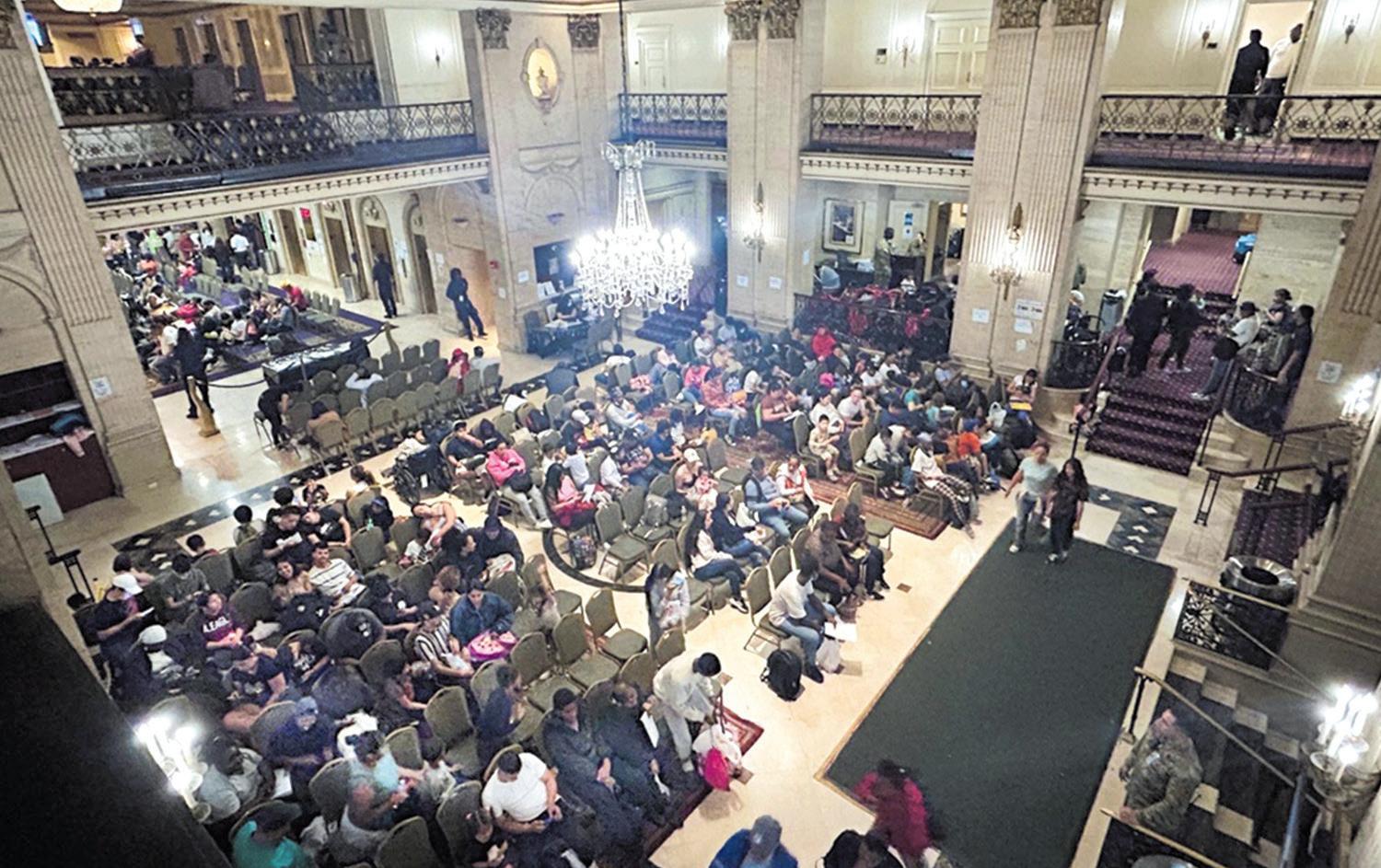

name) from the Bronx who is a NYC resident for 30 years welcomed the closure of the center.
“As a U.S. citizen, a taxpayer and a retiree with no particular political affiliation, I totally agree with the closure of the asylum seeker center,” she said.
“Two years plus of full city assistance and humanitarian aid is enough. Citizens and legal residents deserve the benefits that these asylum seekers received and enjoyed.”
In its heyday, The Roosevelt Hotel a well-known Manhattan hotel among tourists and city residents. Among Filipino Americans, the hotel served as a resting place before attending the Philippine Independence Day parade in June. Community leaders were known to check in at the hotel a day before the parade so they didn’t have to worry about parking or walking too far from Madison Avenue huffing and puffing while elegantly dressed. They could stay overnight after the parade before heading back to their homes in New Jersey or Connecticut.
The Roosevelt Hotel permanently closed its doors in 2020 due to continued financial losses associated with the COVID-10 pandemic, according to reports. Named in honor of President Theodore Roosevelt, the 19-story building opened in 1924. The hotel is owned by Pakistani International Airlines (PIA), a state-run Pakistani company since 2000.
By Bella Owens
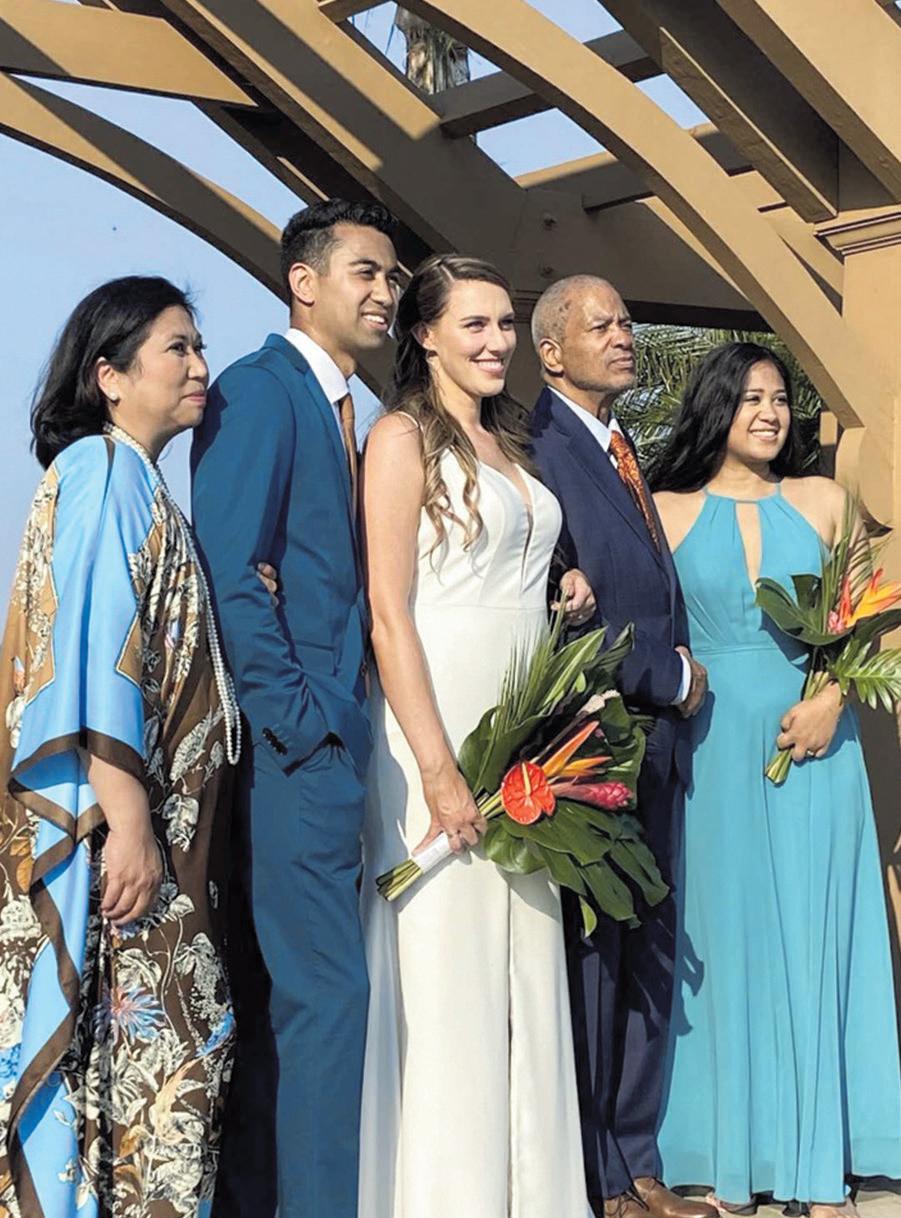
Lewy Body Dementia has been in the news lately because of the famous people suffering from it.
Four years ago, our son got married at a destination beach wedding in Southern Maryland. Southern Maryland has a small-town vacation vibe, with scenic waterways and tall trees canopying the narrow, two-way roads.
We stayed the whole weekend to celebrate this joyous and exciting occasion, which was the first for my small family.
Our son and his fiancée decided to have the whole wedding at the same place to make it easy for the wedding party. We had the rehearsal dinner by the water on the eve of the wedding, the ceremony and the wedding reception were walking distance away, and the traditional after-wedding party was in the bridal suite in the early morning.
Traditions dictate that the father helps his son get ready for the wedding. I tried to get my husband to go
over and help Michael get ready, but I noticed he was not so inclined, so I did his part.
My husband and I walked together during the wedding ceremony, and I could sense he was getting overwhelmed. Immediately after the wedding dinner and traditional dances, I suggested he rest. He eagerly agreed to be walked back to our suite.
I noticed that sufferers of Lewy Body Dementia get tired faster after new activities and sensory overload hits. Also, their confusion is more aggravated with new surroundings.
When everyone was asleep, I woke up around 3 a.m. and noticed my husband was not in bed, I told myself he was just in the bathroom. After 15 minutes, I got up to check and he was not in the bathroom nor anywhere in the suite of rooms we were occupying. I went outside as our suite had two rocking chairs facing the water, thinking maybe he was outside enjoying the early morning air. He was not there.
I returned inside and retrieved the room key, as the door automatically locks once it is closed. I noticed then that one of the rocking chairs fell sideways by the plant bushes.
There were three pathways: left led to the events building, straight up led to the beach, and the right led to the parking and exit. I turned right and started yelling his name. I was in my pajamas running in the pathways that led to the main road, yelling his name under the glaring streetlights. It was eerie.
I ran back and went straight to the beach; I kept on calling his name, I was crying thinking of the worst.
I ran back to the street yelling his name. After what seemed to be a lifetime, although it may only be a few seconds, I decided to call 911 and I reported him missing, I told them of his illness. I was asked for the exact street address; I did not know so I ran back to the front of the main building because I remembered seeing it there.
I was debating if I should wake up my children. I know they just went to bed because of the afterparty. Instead, I ran back to the suite and woke up my brother and sister-in-law, and asked for their help.
We went back out again and split the pathways among us. After what seemed an eternity, I saw him walking back towards me with my sister-in-law coming from the event’s’ building path.’
He was shivering and crying. He told me he kept yelling my name, and that he heard me calling him. He saw the lights across from the water and he thought I was on the other side. He told me I did not come for him. It was the first time I saw how afraid he was.
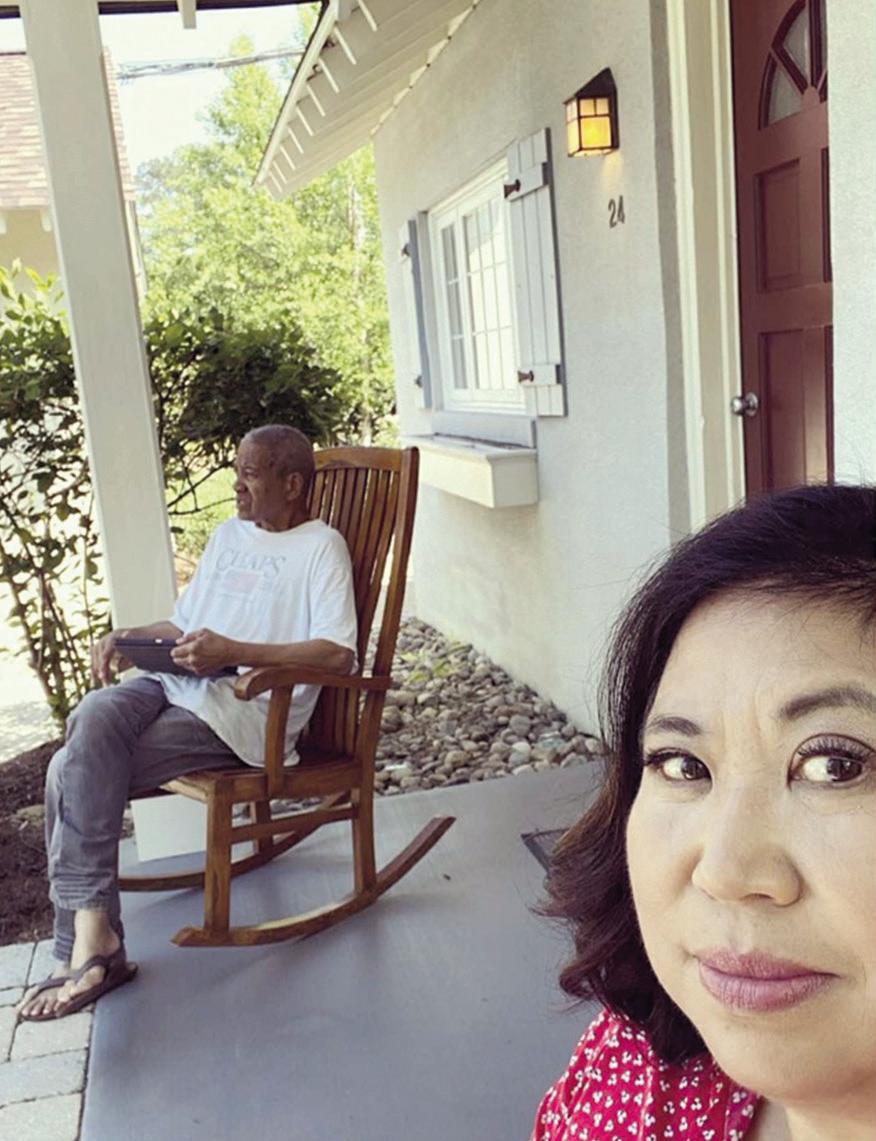
He was barefoot and the rocks from the beach cut his feet. I cleaned him up and put him to bed. After a few hours during breakfast, I told our kids what had happened.
As we drove back home, I kept on playing in my mind what transformed. It took me a week to process what had happened and the true nature and stage of his illness. I finally sat our children down and told them what I have been dreading, to admit that his illness has progressed.
Our children are very smart and are attuned to what has been happening. We started preparing for their dad’s final days with maturity and so much love. He passed away in 10 months.
I promised I would just keep our story to myself. This July 2025 would have been our 36th wedding anniversary.
I just learned that we are created in this world for human flourishing. Any beautiful story—whether good or bad—should be celebrated and shared with humanity to help others hopefully flourish.
This illness is real and heart-breaking for anyone to go through but making the most of your time together as a family can be the most beautiful thing in the world!
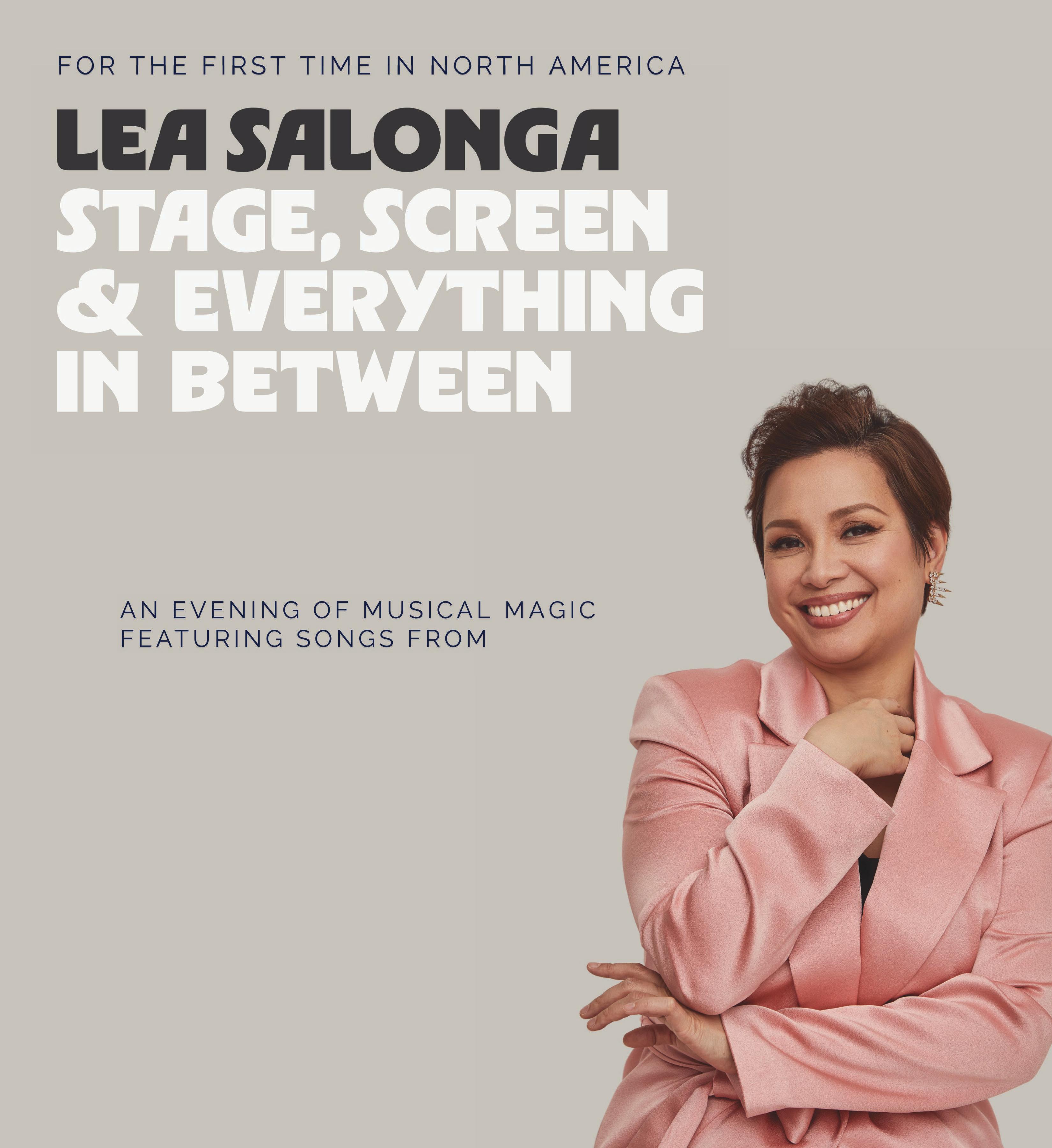
By Catherine Espejo
The Blake Lively vs Justin Baldoni controversy is one of the bizarre incidents involving an alleged case of sexual harassment in Hollywood.
The case also put a spotlight on the role of an intimacy coordinator (IC) who was supposed to prevent exploitation of actors while filming romantic scenes.
What is an intimacy coordinator and what is expected of them during the filming of sex scenes?
Angelica Gomez, one of only a handful of Filipino intimacy coordinators in the United States, explained to The FilAm what an IC does.
“An intimacy coordinator is someone who choreographs simulated sex or intimate moments in television and film,” she began. “They advocate for consent, boundaries, and safety protocols with actors and crew so that closed set shoots are successfully accomplished.”
What she means is that sex scenes are not an excuse for actors to grope, commit lascivious acts or make the other actor uncomfortable during love scenes. While Lively has taken Baldoni to court for alleged “sexual harassment” during the filming of “It Ends With Us,” the latter denied the accusation maintaining an IC was present while they were filming and that no such incident had occurred.
“It’s such a long-drawn-out thing and I don’t know what the motives are,” Gomez said when asked for her thoughts about the case. “There’s a reason why the intimacy coordinators were there. They’re adults. It’s their decision.”
Gomez, 61, became exposed to what an IC does when she appeared on an episode of “Law & Order: Organized Crime” where her shower scene entailed partial nudity. The IC provided to her explained the logistics of how they would assist her during filming.
After her experience, it sparked her curiosity in her considering a career as an IC. Gomez pursued online classes through the Intimacy Directors and Coordinators Professionals, Inc. Accelerated Online (IDC). She began the course in April of 2024 and received her certification by November 2024.
Gomez was grateful to her instructors at the program. Alicia Rodis is considered the “pioneer of the career” and is the first credited IC in “The Deuce” television series. Jessica Steinrock started IDC alongside her husband. Amanda Blumenthal shared her insights on how ICs navigate the industry. These women, said Gomez, helped create a relatively new career in the industry and brought it to where it is now, a growing profession booming with opportunities in cinema and television.
The IC industry is very community-oriented, said Gomez. “Everyone is in this together. There are even Facebook groups. People refer possible upcoming
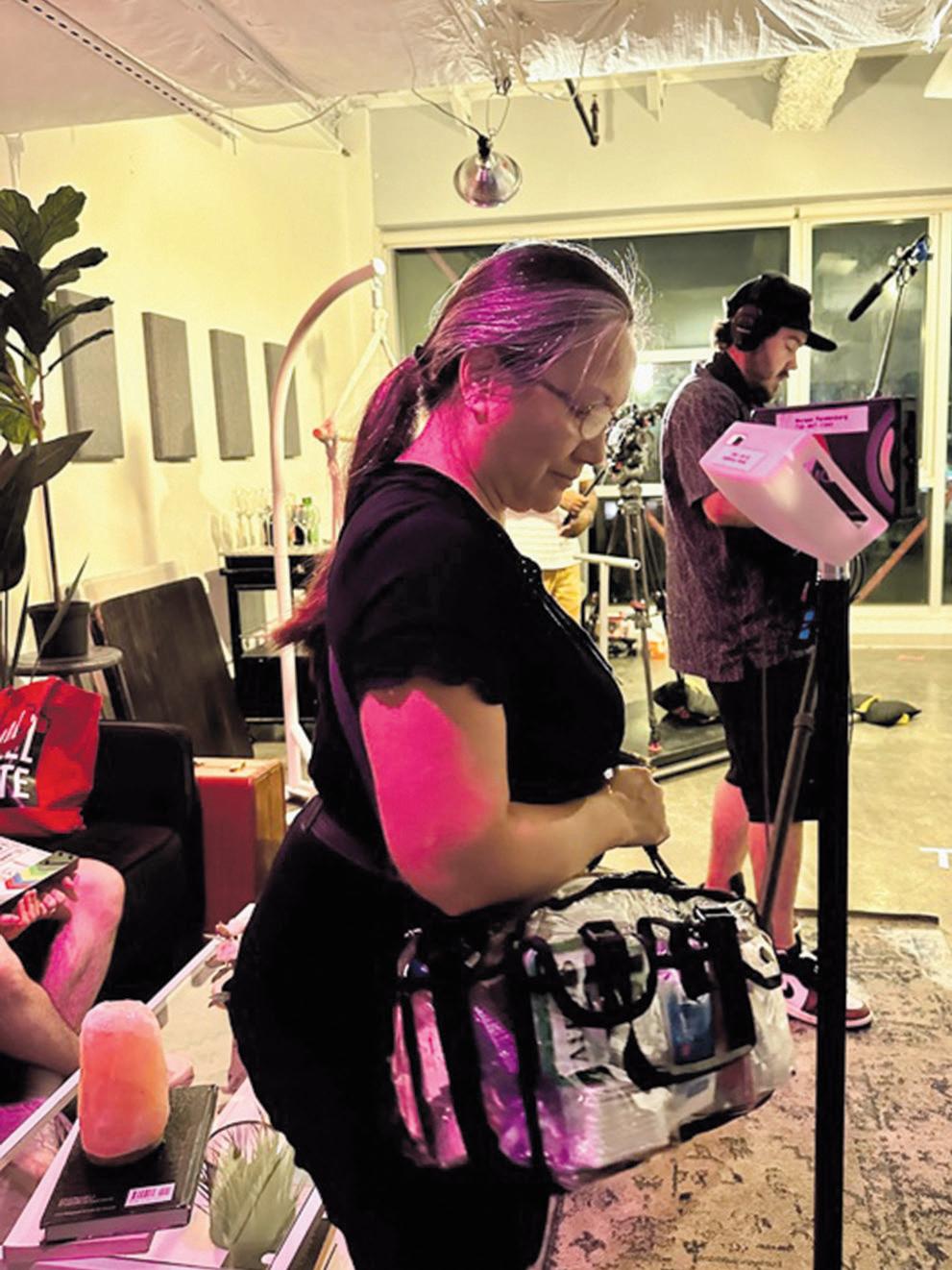
projects to others without even having met in person. Through this community, I was introduced to a Filipino intimacy coordinator in the Manila via Instagram video message, named Missy Maramara. We had a wonderful conversation and I was inspired by her. Missy said that she was one of only two intimacy coordinators in the Philippines. The career doesn’t have a traditional path.”
Gomez grew up in Manila and migrated to America when she married a Filipino U.S. Navy sailor. Prior to joining the television/film industry as an actor and active member of its union, Sag-Aftra, Gomez worked in the fashion industry for over 12 years.
Gomez shows a deep passion for her career as an IC. The salary rate varies, depending on the budget of the film, she said.
“The weekly rate fluctuates,” she said but Gomez respects the budget being a newbie in the field. Right now, it’s about learning new things and broadening her potential career ventures, she said.
“The importance is not about monetary value but gaining experience.”
Gomez described herself as “empathetic,” ensuring that the screen environment is comfortable for the actors and even the production crew. She highly emphasizes communication amongst her peers to establish relationships before embarking on any project.
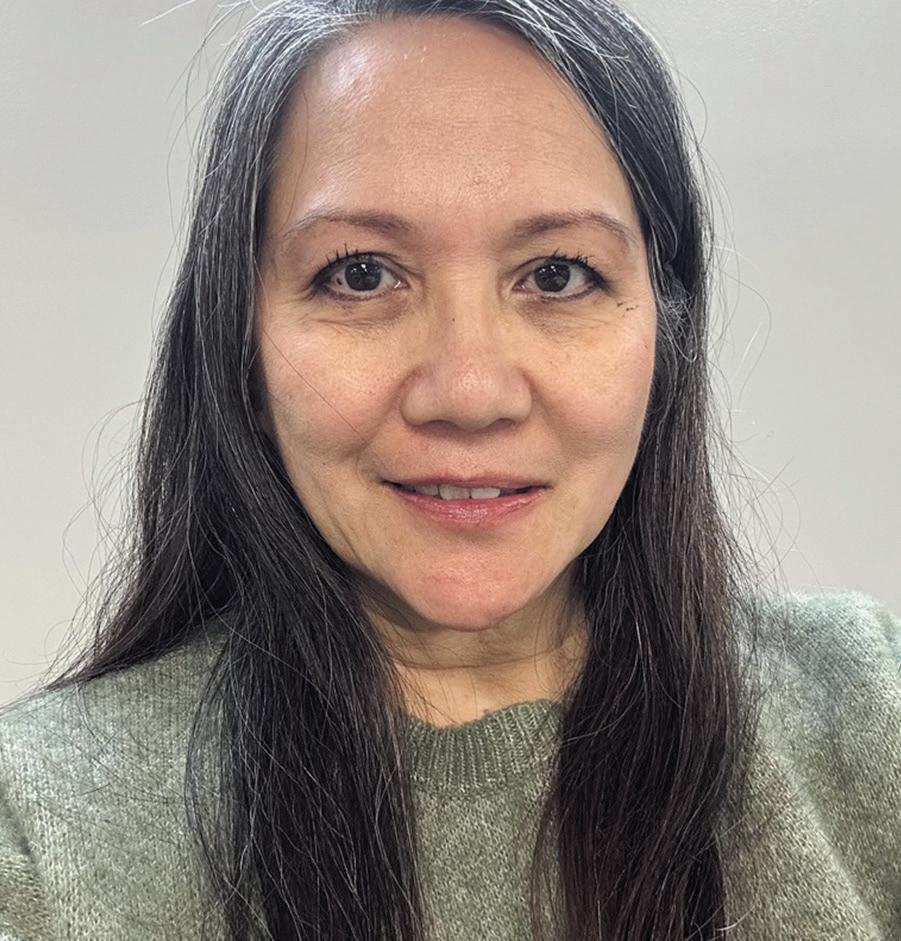
She uses what she calls “riders” as part of the industry standard protocols to communicate a safe working environment. “Riders” are essentially paperwork describing the scene for the actors to sign off and give their consent and boundaries. There’s also a 48-hour grace period for review should the director or writer want to add more to the scene or make changes and adjustments even before this can take effect.
Being an IC can also be met with resistance, she said. For example, she said some male actors would like to take advantage of inappropriate behavior and consider the job of IC “useless.”
Gomez emphasizes the importance of her intimacy coordinator kit that she always carries on set. It contains a plethora of items to ensure safety as well as comfort for the actors. It contains breath mints, alcohol pads, adhesive covers, and different types of skin tape, modesty garments, to name a few. There are different items for various needs. Gomez said she comes to the set prepared.
Some items Gomez created herself which she provides personally. “There’s padding for barriers I made by cutting up a yoga mat. I also have a small partially inflated beach ball I use for a barrier.”
Gomez is eager to gain more experience to establish her name. Her newest endeavor includes working on a student film for a future director studying in Columbia University, along with other potential summer projects. Ultimately, her biggest aspiration would be to work with the Filipino community and their projects. She takes pleasure in knowing that she did a thorough job in creatively making the set and scene not only comfortable and safe but also realistic and authentic to the director’s vision of the story.
Amplify AAPI has released its latest Cross Industry Report, offering valuable insights into the brand preferences, media habits, and purchasing behaviors of AANHPI communities—compared to U.S. adults and other racial groups. Created by NORC at the University of Chicago with support from AARP, Amplify AAPI is the largest and most representative public opinion panel of Asian American, Native Hawaiian, and Pacific Islander communities.
Here are just a few insights from the latest data: https://amplifyaapi.norc.org
Of the top 10 brands that AANHPI community members own or lease, seven are Asian auto manufacturers; 3 in 10 said they own or lease a Toyota. AANHPI adults own or lease more Toyota and Honda vehicles than other U.S. adults do. Fewer own or lease Chevrolet and Ford vehicles.
AANHPI communities say their favorite airlines are Delta and Southwest, followed by United Airlines.

AANHPI community members say their favorite grocery store is Costco, followed by Trader Joe’s.
Netflix and Prime Video are the clear favorites for streaming TV. Six in 10 AANHPI community members have subscriptions to the two services. Older AANHPI members—Boomers and members of the Silent Generation—are less likely to subscribe to Prime Video, Hulu, Max, and Apple TV+ than AANHPI Millennials. AANHPI adults subscribe to Disney+, Paramount+, and Peacock far less than other U.S. Adults overall.
Sixty-six percent (66%) of AANHPI community members are on Facebook, and more than half are on Instagram. AANHPI communities use Snapchat less than other groups and use LinkedIn and WhatsApp much more than other groups. In fact, AANHPI communities use WhatsApp over twice as much as white U.S. adults. For AANHPI communities as a whole, Facebook is the most-used social media platform. Among Millennial AANHPIs, Instagram and LinkedIn are also popular.

Over the last six months, two-thirds of AANHPI community members used Amazon Prime. About four in 10 used Costco, Walmart, and Target to shop online in the last six months. Over the last six months, AANHPI community members shopped online at Costco, Target, and Amazon (without Prime) more than U.S. adults as a whole.
AANHPI community members stay
informed about politics and current events through mainstream news outlets and social media. AANHPI adults use online news platforms and podcasts to stay informed, more so than other U.S adults.
Zelle and PayPal are the most popular financial apps among AANHPI communities; seven in 10 foreign-born AANHPI individuals use Zelle.

In a career spanning decades and continents, Tony Award-winning performer Lea Salonga has made a home in the hearts of Filipino theatergoers in the Philippines and around the world.
Two Filipina Americans describe what Lea meant to them growing up.
“Since I was a little girl,” reminisced artist Ann Constantino Beck, “I have loved Lea Salonga's rendition of ‘A Whole New World’ with Brad Kane.’ I continue to enjoy it today. She is an artist I greatly admire.”
Jessy Daing, an executive at NYC’s Metropolitan Transportation Authority, remembers Lea “since I was a kid” when she watched her film a Sanrio commercial in a Manila mall.
“I distinctly recall hearing her flawless, pitch perfect voice at such a young age, and I just knew then that this little girl was destined for greatness.”
Lea has made such stirring impact in the hearts of many young Filipina girls who grew up with her music and idolized her immeasurable talent.
By Cristina DC Pastor
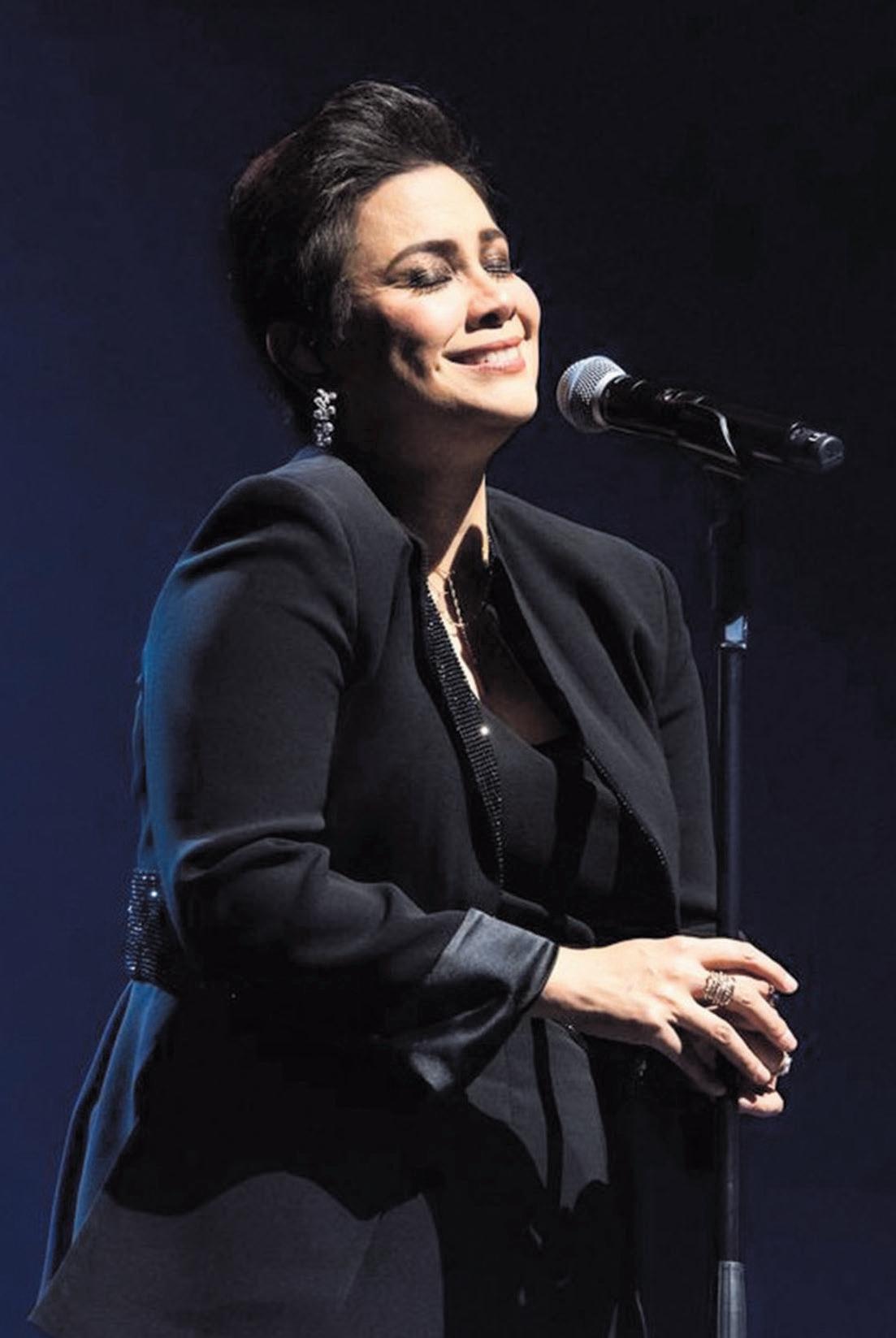
‘I wouldn’t have lasted this long if it wasn’t fun.’
This beloved artist who has conquered Broadway and Disney is set to receive one of the entertainment industry's most iconic honors—a star on the Hollywood Walk of Fame. Other luminaries have been there before her -- namely Bruno Mars, apl.de.ap, and Rob Schneider – but to be the first Filipina?
“Kinda great to be the first Pinay to get it!,” she tells The FilAm in an email interview. “Truly an honor.”
“It’s one of those things you think about and dream about, but never really think it will come true. And yet here we are! It’s wonderful!” she continued.
She found out the big news on coming home from travel and still suffering from jet lag.
“I woke up very early that morning, around 5:46 a.m., and went on social media. There were already posts congratulating me for the star, but I didn’t believe them right away. It was when my manager sent a text saying, ‘Call me before you look at any social media, email or text’ that it really hit home that it was true! I mean, wow! I’m still quite stunned about it all, to be honest!”
On October 20, Lea will headline a concert called “Stage, Screen & Everything in Between,” at the Town Hall. In this show she has done in the UK and the Philippines, she will be singing the “familiar hits from the worlds of the stage and the movies.”
Musical theatre fans will experience stage and screen classics from “Miss Saigon,” “Les Misérables,” “Aladdin” and “Mulan,” plus newfound favorites from the critically acclaimed Broadway and West End

At ‘Miss Saigon’ where she became an international legend. Photo: leasalonga.com

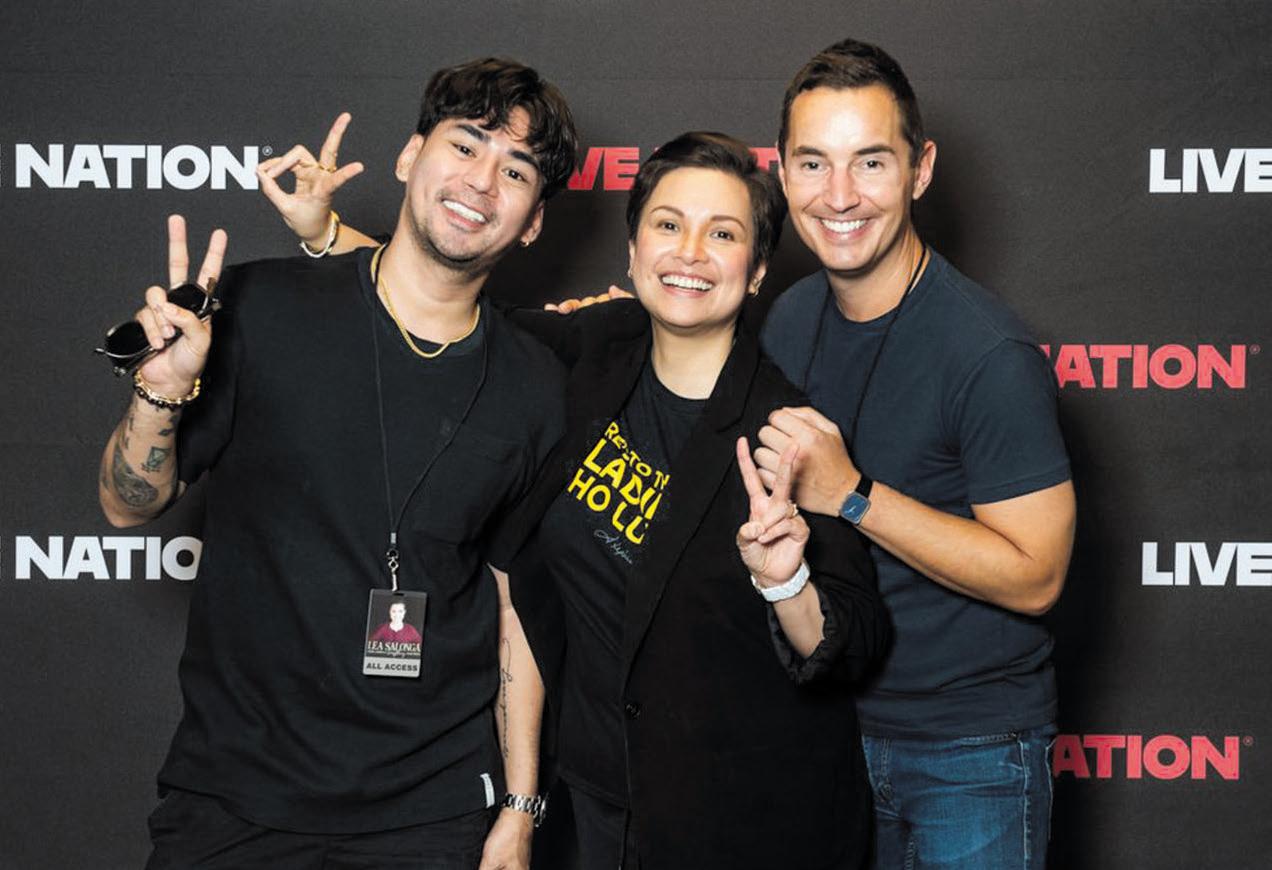
has been “such a fun profession.” While others might consider her childhood unusual, she sees it differently.
“Normalcy is relative...I don’t know what it’s like to not be a performer, so as far as I’m concerned, what I’m doing is normal in my world,” she said.
The intrigues and pettiness in the industry, she has learned to mute and brush aside “those things (that) come from small people with smaller minds.” She is grateful for all the luck and goodwill that have come her way and to have worked with the “most incredible people” on and off stage.
hit “Old Friends,” Broadway blockbusters, pop classics, all from her celebrated career.
She added, “The format is familiar, but I don’t think I’ve had this much fun in a traditional concert setting. We put so much love into creating this set list, and there’s also so much love whenever we perform it. It’s not just a concert—it’s a love letter to musical storytelling, crafted with passion by Salonga and her team.”
To Lea, performing since the age of 7 on Philippine stage and television,

“I honestly just have the best time. Acting and singing are fun! Getting to disappear into a character and play dress-up for a few hours brings me immeasurable joy, and I hope the audience sees that. I wouldn’t have lasted this long if it wasn’t fun,” she said.
Though her voice is one of the most recognizable in the world of musical theater, Salonga’s journey has experienced a rare vocal hurdle.
“While I was in “Miss Saigon” in London, there was a time when I didn’t actually know what was happening with my voice. It was failing me, and I wasn’t equipped to handle it.”
She took a break under medical advice and returned to singing only after intensive voice training. The experience reshaped her approach: “I learned how to sing properly, heal, get stronger, and keep going.”
If she was not a performing artist, what would she like to do?
At the age of 9, she had announced she “wanted to be a psychiatrist or in today’s parlance, a therapist. Perhaps I was just curious about what made human beings tick. Today, I’m an actor with that same curiosity. So perhaps in that way, I fulfilled my childhood ambitions.”

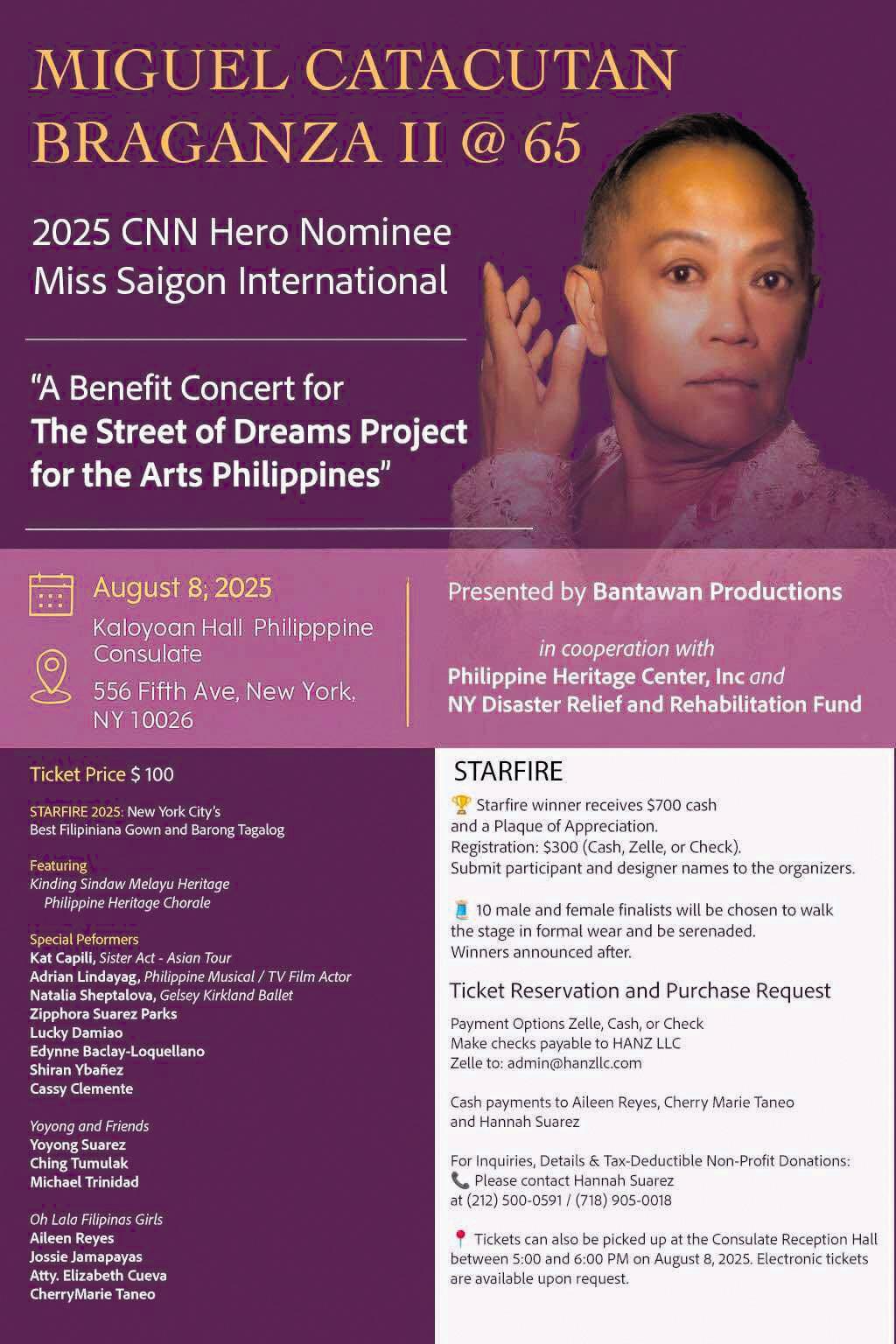
| Ongoing till September 1
Common Picnic: Halo-Halo Edition by artist Risa Puno Waterfront Plaza at Brookfield Place 230 Vesey Street NYC
| Ongoing until October 5
Golden Years Weighing Philippine Martial Law 1972-1981
Curated by Victor Barnuevo Velasco
Asian American Resource Center 8401 Cameron Road Austin, TX
| Ongoing till January 18, 2026
Abang-Guard: Makibaka featuring artists Maureen Catbagan and Jevijoe Vitug
Queens Museum
Flushing Meadows Coronal Park
Queens NYC
| August 8
Miguel Braganza benefit concert for the Street of Dreams Project for the Arts
Kalayaan Hall
Philippine Consulate 556 Fifth Avenue NYC
| August 10
People’s Ball
Newark Liberty International
Airport Marriott 1 Hotel Road Newark, N.J.
| August 16 & 17
Fiesta In America
American Dream Mall
1 American Dream Way East Rutherford, N.J.
| August 19 & 20
Consular Outreach in Attleboro, MA
La Salette Shrine 947 Park Street
Attleboro, MA
| August 22
Yaman ng Lahi Award (Treasure of the People Award) by IAM FAME
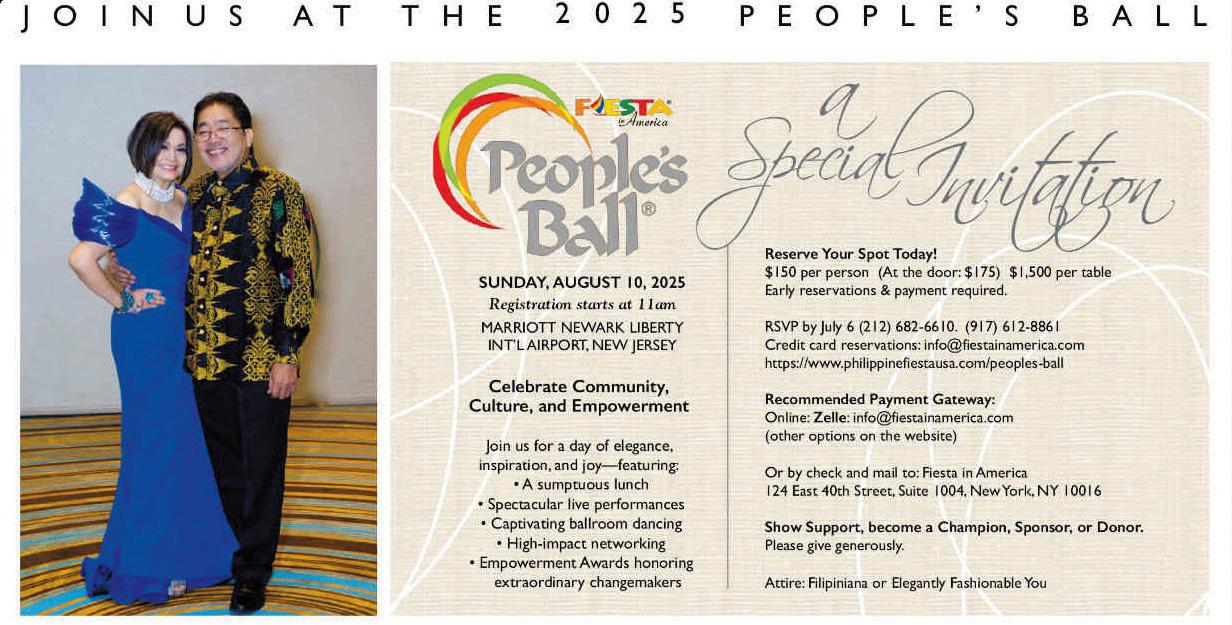

Leonard’s Palazzo
555 Northern Boulevard
Great Neck, N.Y.
| August 23
PIDCI Maria Clara Ball
Astoria Manor
25-22 Astoria Boulevard Astoria, NYC
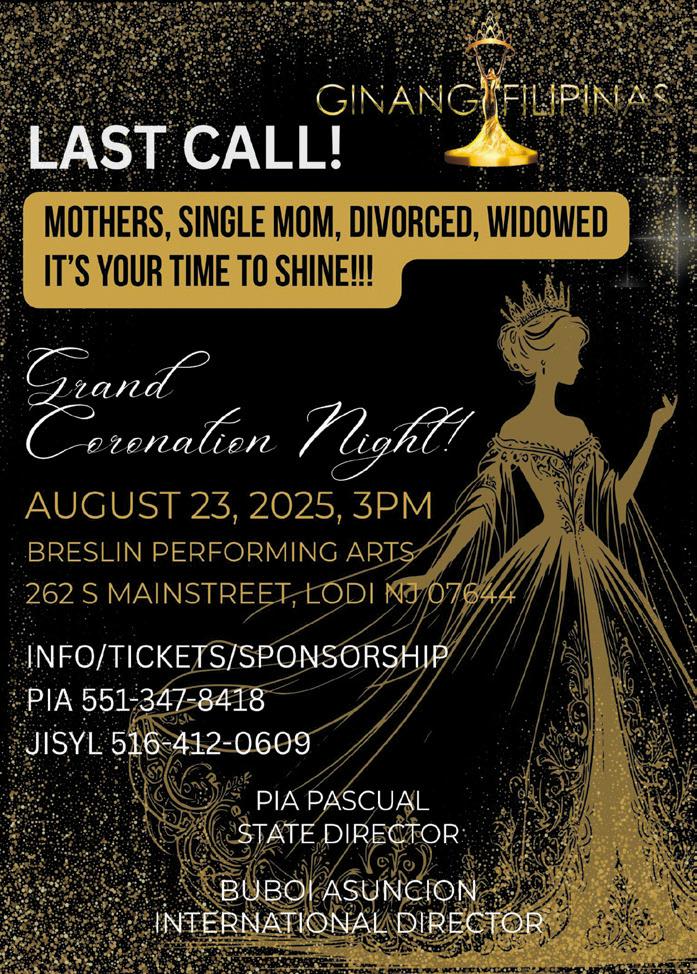

| August 23
Ginangs of New Jersey Grand Coronation Night
Felician University
Breslin Performing Arts
262 South Main Street
Lodi, N.J.
| August 31
Comedy Rumble USA
Tour 2025
Conlon Hall
19 N. Williams Street
Bergenfield, N.J.
| September 6
Heritage People’s Ball
Marriott Fairview Park Hotel 3111 Fairview Park Drive Falls Church, VA

| September 12 & 13
New York Fashion Week by Steadfast Creative Arts Production
Edison Ballroom
240 W 47th Street NYC
| September 13
Knights of Rizal 2nd Commander’s Ball
Terrace on the Park 52-11 111th Street
Queens, NYC

| October 3 to 5
Philippine Nurses Association of America, Inc.’s 22nd Eastern Region Conference with the theme ‘Impacting Lives, Influencing Change’
Live Casino & Hotel Maryland 7002 Arundel Mills Circle Hanover, MD

| October 5
Gala Filipiniana by the Filipino Apostolate Archdiocese of Newark Park Hotel at Meadowlands Two Meadowlands Plaza East Rutherford, N.J.

| October 12
5th Anniversary of the Filipino American Cancer Care: Fashion for Love, Care and Hope Charity Gala
Hyatt Regency Reston 1800 Presidents Street Reston, VA
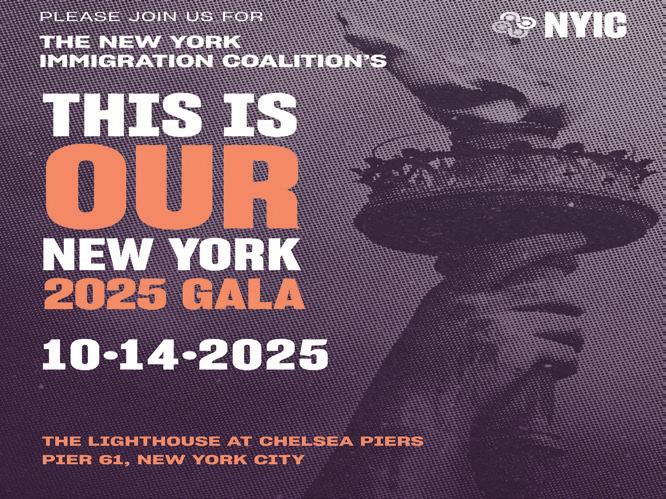
| October 14
This is Our New York 2025 Gala by the NY Immigration Coalition Lighthouse at Chelsea Piers Pier 61, NYC
| Oct 17 to 18
UPAA in America’s 23rd Grand Reunion and Convention Westin Galleria 5060 W Alabama Street Houston, TX
| October 20
Lea Salonga: Stage, Screen & Everything In Between The Town Hall 123 West 43rd Street (Between 6th Avenue and Broadway) NYC


President Ferdinand ‘Bongbong’ Marcos Jr.’s July 22 meeting with U.S. President Donald Trump has resulted in only a 1 percent cut in tariff rates from the original 20 percent to be imposed on Philippine goods entering the U.S.
“The Philippines will pay a 19 percent tariff,” Trump announced at the end of the bilateral meeting at the Oval Office. He later called Marcos “a tough, negotiator.” "It was a beautiful visit,” Trump also said. “We concluded our trade deal, whereby the Philippines is going open market with the United States, and zero tariffs."
Trump lavished praise on the Philippine president. “It was a great honor to be with the president. He is highly respected in his country, as he should be. He is also a very good, and tough, negotiator. We extend our warmest regards to the wonderful people of the Philippines!"
As of press deadline, the Philippines has yet to issue an official response to Trump’s tariff declaration.

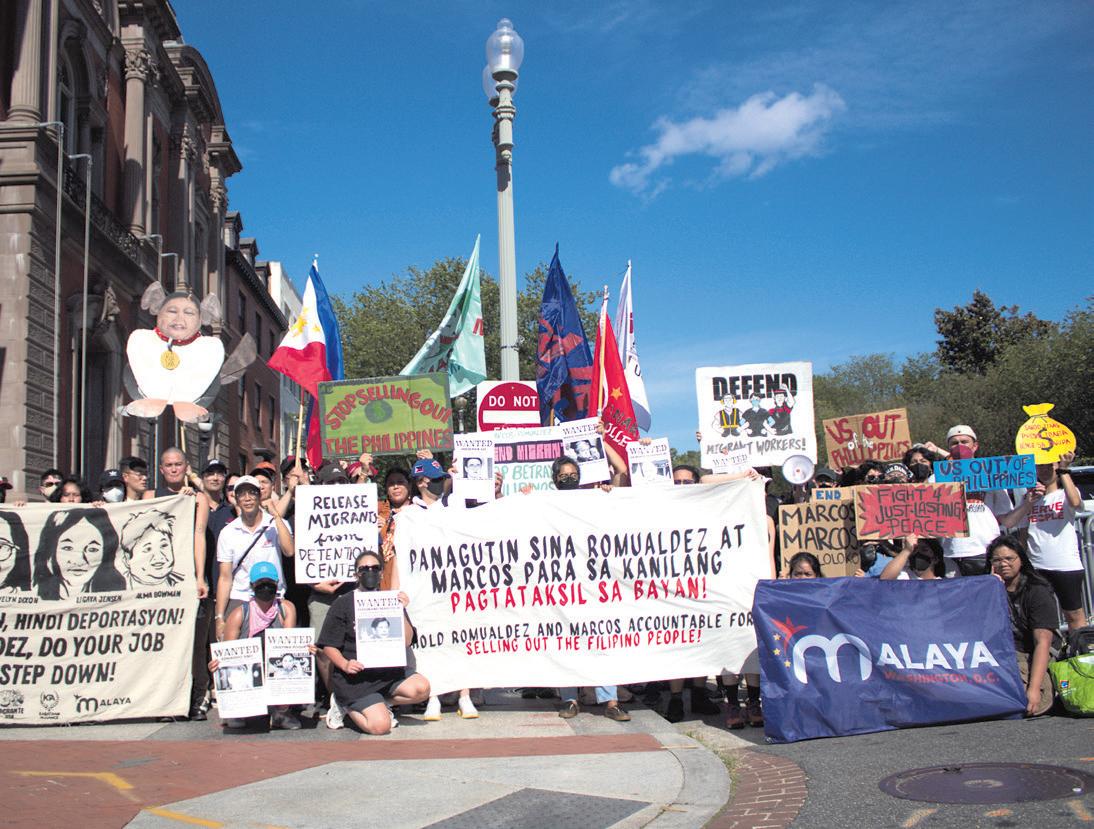
and economic cooperation, especially in light of the recently imposed 20 percent U.S. tariff on Philippine exports…and convey(ing) to President Trump that the country is ready to negotiate a bilateral trade deal that will ensure strong, mutually beneficial and future-oriented collaborations that only the United States and the Philippines will be able to take advantage of.”
Trump’s controversial immigration policy was not on the agenda.
Outside the White House as the meetings with U.S. officials were in progress, Filipino activists urged Marcos to “stand with your people!” and to “put the Philippine economy and migrant welfare first.” They also raised the alarm over the 1 percent excise tax on cash-based remittance transfers from the U.S. to recipients abroad.
Marcos was in the U.S. July 20 to 22 for discussions on tariffs and military security as it pertains to the West Philippine Sea. His meeting with Trump is the first by an Association of Southeast Asian Nations (ASEAN) Head of State since the U.S. leader’s return to office earlier this year, according to a Malacañang press statement.
Before departing, Marcos has said his priority concerns during the visit include “enhancing trade
“Even a 1 percent tax of non-citizens is huge over time, and carries with it the risk of surveillance in verifying one's citizenship status,” said Jom Dolor, deputy secretary general of Migrante USA in a press statement.
The activists denounced the absence of any discussion on immigration.
“The immigration crisis faced by migrants under Trump was noticeably absent from Marcos’ agenda due to ‘limited time.’ How can he have no room for discussion and no time for the Filipino community when we are facing fascist raids at hospitals, churches, elementary schools?”, said Dolor.
The Philippine Consulate will spotlight the talent, creativity, and heart of independent Filipino filmmakers at the Sinehan sa Konsulado, which will be held on August 19 and 20 at the Kalayaan Hall in New York.
This year’s Sinehan sa Konsulado (SSK), presented in partnership with the National Commission for Culture and the Arts (NCCA) and the Philippine World War II Memorial Foundation, will showcase a diverse lineup of films.
On August 19, two movies (“Honor: The Legacy of Jose Abad Santos” and “Children of the War”) will be shown to honor the courage, sacrifice, and enduring legacy of Filipino heroes in commemoration of the 80th Anniversary of World War II and the Philippine National Heroes Day.
On August 20, a short film that tackles societal expectations regarding the “proper” roles of women (“Winged Dreams to the Blue Heavens”), a film depicting an emotional journey of faith and spirituality of a man who searches for his missing wife (“Salog Ning Diklom” or Black River), and a romance drama shot in Negros Occidental and which showcases the beauty of the Ilonggo language (“Azucar”), are featured.

Schedules:
Tuesday, August 19 at 6:10 PM: “Honor: The Legacy of Jose Abad Santos” Tuesday, August 19 at 7:30 PM: “Children of the War” Wednesday, August 20 at 6:00 PM: “Winged Dreams to the Blue Heavens” (2020) and “Azucar” (2019)
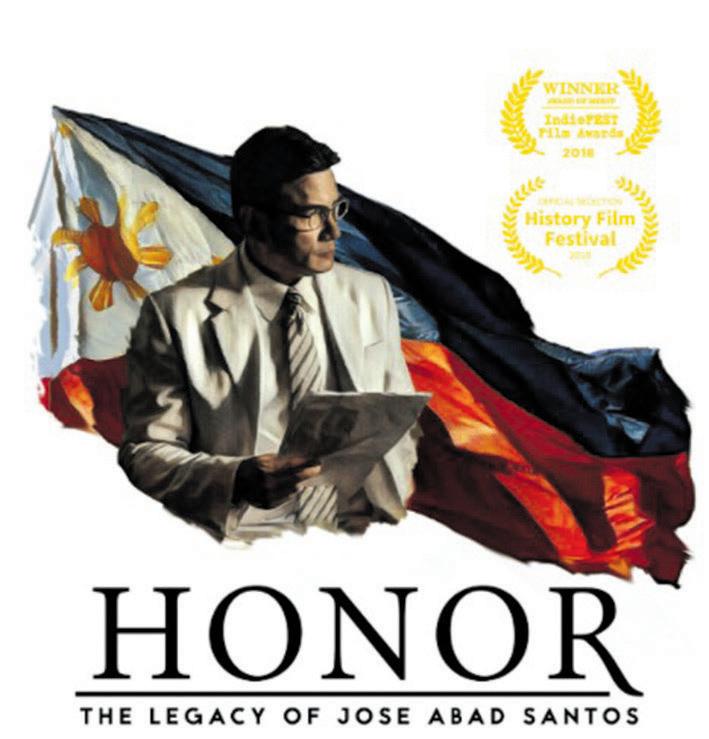
Wednesday, August 20 at 6:10 PM: “Winged Dreams to the Blue Heavens” (2020)
Wednesday, August 20 at 6:30 PM: “Salog Ning Diklom” or Black River, (2020)
Wednesday, August 20 at 7:00 PM: “Azucar” (2019)



“At age twelve, Paula confronts a school bully who folded easily. Her US Marine father has taught her courage amidst challenges, her school-teacher mother has instilled in her compassion with cleverness. Then she meets a senator who, growing up, has faced enormous life adversities and humbly bears those same traits. An unlikely friendship ensues.ˮ
Gene P. Del Carmen
The FilAm readers get reduced shipping price, author-signed copies.
Order @ gpdelcarmen@gmail.com



By Cristina DC Pastor
Philippine National Bank’s General Manager Eric Bustamente has a lot of explaining to do as the U.S. government prepares to impose a 1 percent excise tax on certain remittance transfers from the United States to a foreign country starting January 1, 2026.
First, he must break down to Filipinos in the U.S. how President Donald Trump’s “One Big, Beautiful Bill” became law, and what it means to their remittances in the coming year. Because Bustamante has led PNB New York in terms of profitability and customer service for many years, he
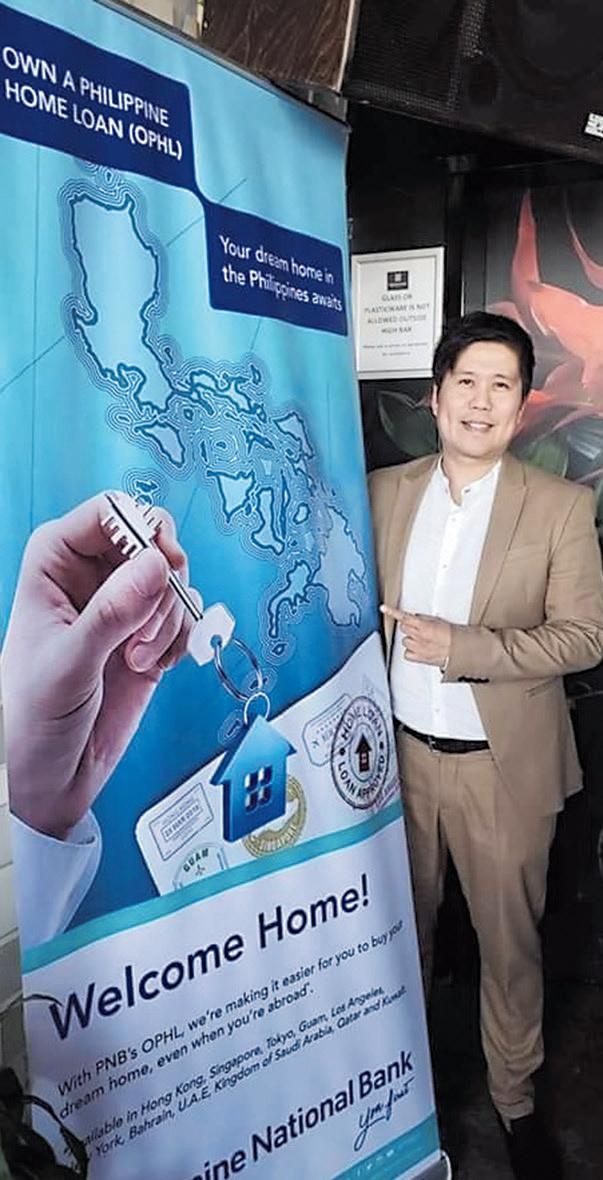
wanted to make sure FilAm clients understand the implications to their cash flow and savings.
In the following Q-A with The FilAm, Bustamante pointed out what Filipinos can expect moving forward.
The FilAm: Eric, help me to understand the tax on remittances. All you must do when you send money home is not declare it as remittance, right? Am I missing something?
Eric Bustamante: The 1% tax here is on cash, money orders and similar physical instruments as a source of funding for remittance transfers. Not for the reasons.
The 1% tax will be deducted by financial institutions from remitters. Exempt are funding coming from your U.S. bank account and U.S. credit or debit cards. The tax applies to all individual senders, regardless of their citizenship. The 1% tax will be remitted by U.S. banks to the Internal Revenue Service (IRS).
TF: So, any money sent from the U.S. to the Philippines is consid ered remittance for whatever reason?
EB: Not necessarily, as remittance is only one form of bank transfer and refers to money sent by a person from one country to family members or dependents in their home country, usually for their support, household consumption or savings. The tax is only levied for cash, money order, or similar physical instruments as your source of funding. So, if you go to a U.S. bank and send money to Philip pines using hard cash, then 1% tax is levied.
PayPal will the money be taxed?
EB: orders are taxed. If the source of fund ing is coming from a U.S. bank account or a U.S. bank debit or credit card, it's exempt.
TF: What if the remitter has no bank account?
EB: If they remit in cash, money order or similar physical instruments, then they pay 1% tax.
TF: So, what are the other fees to be paid by remitters aside from 1% tax?
EB: There’s the 1% tax and the regular remittance fees charged by the banks.
TF: What is the average amount remitted by a Filipino family?
EB: It depends on the purpose; it could be graduation or helping someone in need, anywhere from $500 to $1K. So, if you send $500, your excise tax is $5 to be deducted plus the regular remittance fees charged by U.S. banks.
TF: With President Bongbong Marcos about to visit Washington D.C. July 20 to 22 and meeting with Trump, do you think he should raise this concern?
EB: I think he should make it one of the priority agendas since the Philippines relies heavily on foreign remittances from the United States. We are, after all, on friendly terms as allies. The original proposed excise tax is 3.5% and it became 1% in the final bill.
We can only hope for the best for our modern day Global Filipino heroes.
TF: Why is the law effective on January 1, 2026?
EB: We are awaiting guidance on how to proceed. Also, I presumed that U.S. banks were given a grace period of six months to tweak our IT systems to make it compliant with the new law and how the 1% taxes will be received by the IRS.




By Catherine Espejo
Participating in New York Fashion Week (NYFW)—one of the world’s most prestigious fashion events—was more than just a career milestone for Grace Brucal. It was a celebration of culture, craftsmanship, and community.
Brucal grew up in Matacon, Polangui, Albay, a small town in the Philippines that deeply influenced her love for fashion. She credits her mother Cristeta as her earliest inspiration, recalling how she used to watch her skillfully style outfits and sew garments with care and creativity.
“I always wanted unique dresses, so I’d buy fabrics and tell the sewers exactly what I wanted,” she told The FilAm. “Another big inspiration came in 2019, when my daughter was invited to model in New York.”
She is married to a deacon, Ej Brucal, a doctor of physical therapy. They have three children Kristine, Ethan and Kaitlyn. Today, Brucal (she uses the name Steadfast for her

design collection) works closely with a team of co-designers and a rotating cast of 10 to 20 runway models to bring her creative vision to life. Her collections range from formal gowns and casual

Brucal
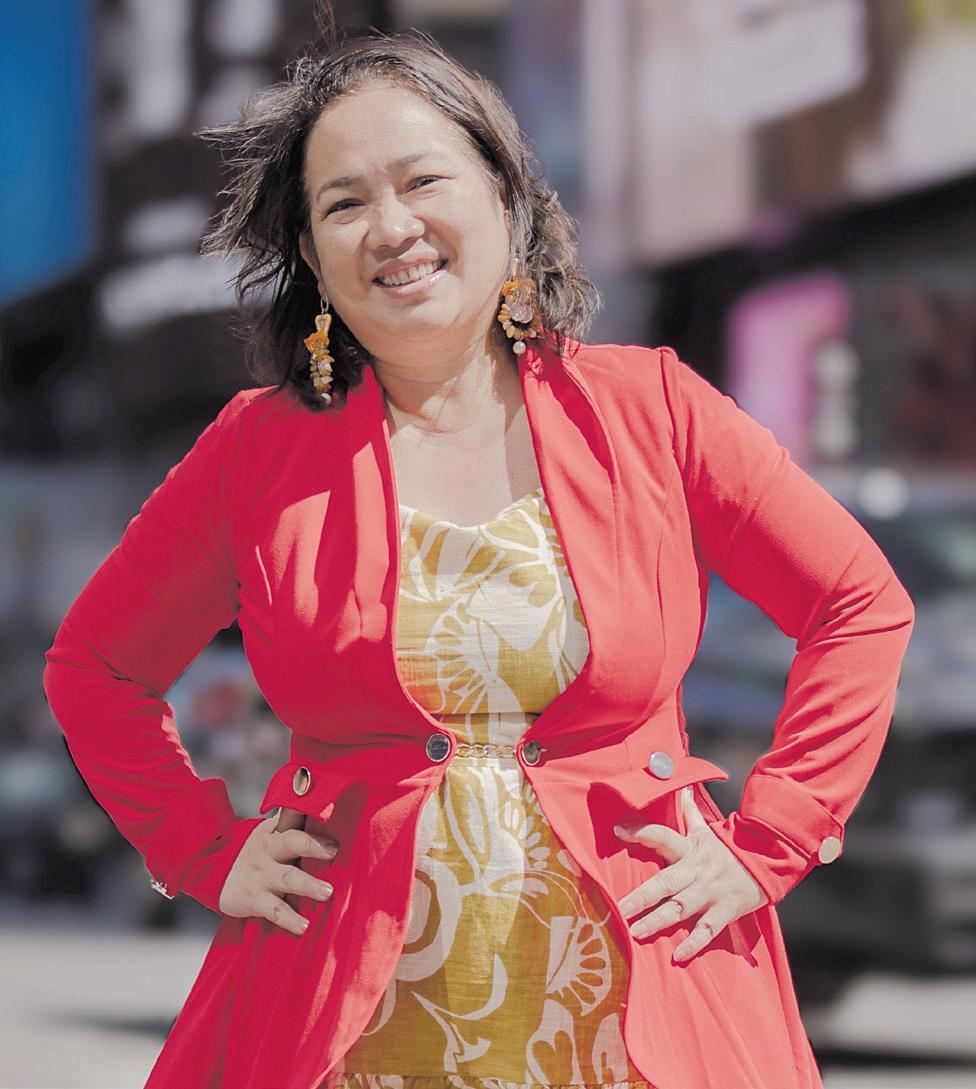
wear to wedding dresses and children’s clothing. She also designs accessories and shoes using sustainable materials like abaca fabric.
Her signature pieces, however, are the modern
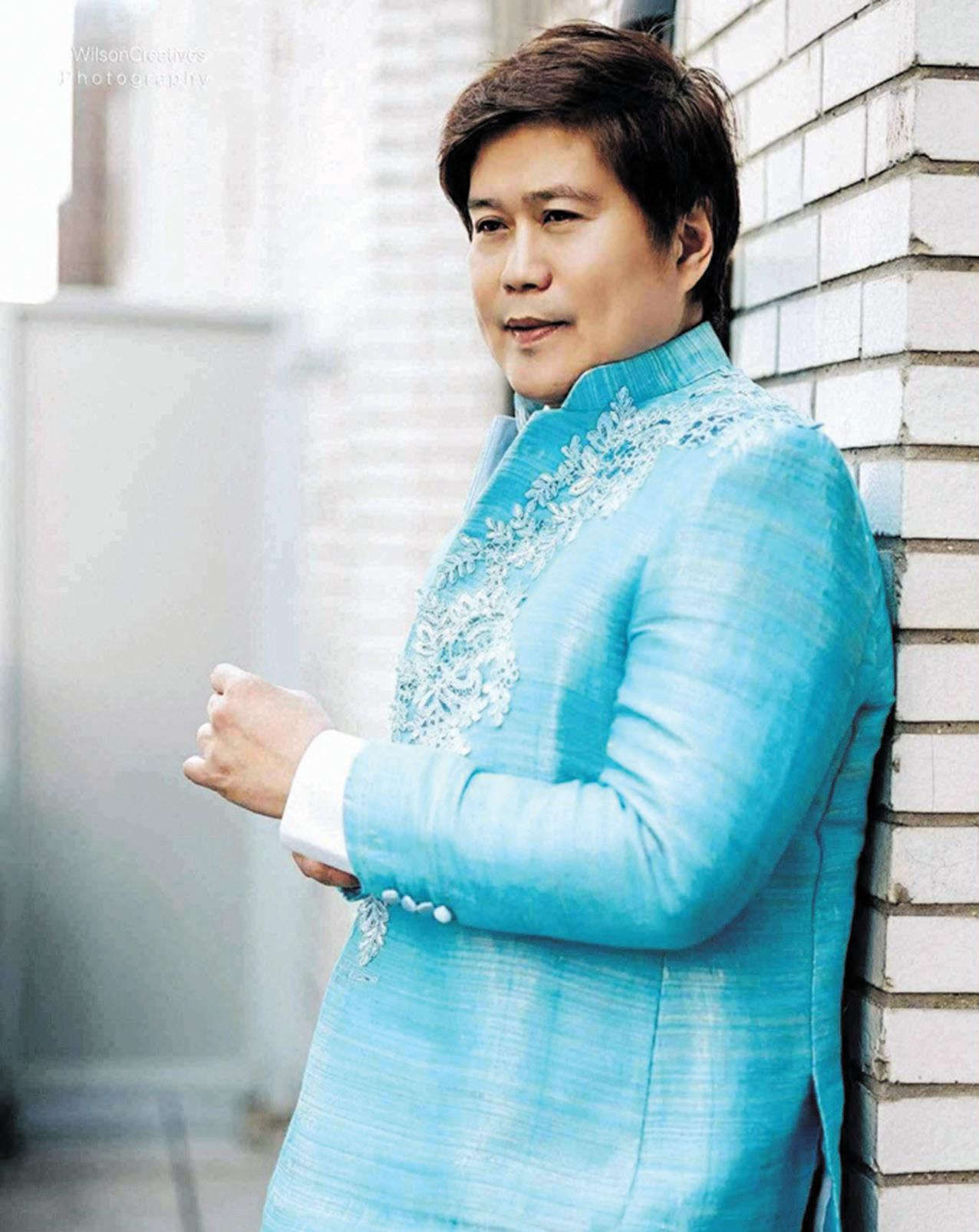
Filipiniana boleros and Barongs. These intricately designed garments pay tribute to her roots, particularly in the Bicol region.
“There’s a growing demand for the Bolero Barong, which I make using Pinukpok abaca,” she explained. “By using this fabric, I’m supporting weavers from Bicol who were displaced by the Mayon volcano
eruption. It’s also a way to provide work for dressmakers and beaders, helping families sustain their livelihood.”
Brucal’s path to NYFW was shaped by multiple influences. She was inspired in 2015 by Miss Universe Pia Wurtzbach’s collaborations with Filipino designers in New York. Then in 2019, her daughter—after winning the title of Little Miss West Virginia Earth—was invited to model at NYFW. In 2022, Brucal launched her own Steadfast label brand.
Outside of fashion, she wears many hats. She’s a physical therapist, an autism specialist, and a modern-day CEO—all while raising a family. When asked how she balances it all, she replied with calm confidence:
“Time management. I control my schedule and plan ahead. I make sure my shows don’t interfere with work or my kids’ activities.”
Like many in the industry, she faces challenges— often overwhelming ones—but has learned to adapt with steady confidence.
“I’m still learning,” she said. “I have to study and manage people back in the Philippines. This wasn’t something I planned—it felt more like a calling to help sustain livelihoods in my hometown.”
Beyond NYFW, Brucal has had many career highlights, including meeting two Miss Universe winners and building connections across the global fashion community. Her greatest joy, she said, is using her platform to uplift others.
“I want to help aspiring models build their confidence while continuing to support the people back home,” she said. “That’s what drives me.”



Issue 89, August 2025
From Amazon to Zelle Asian Americans’s favorite brands
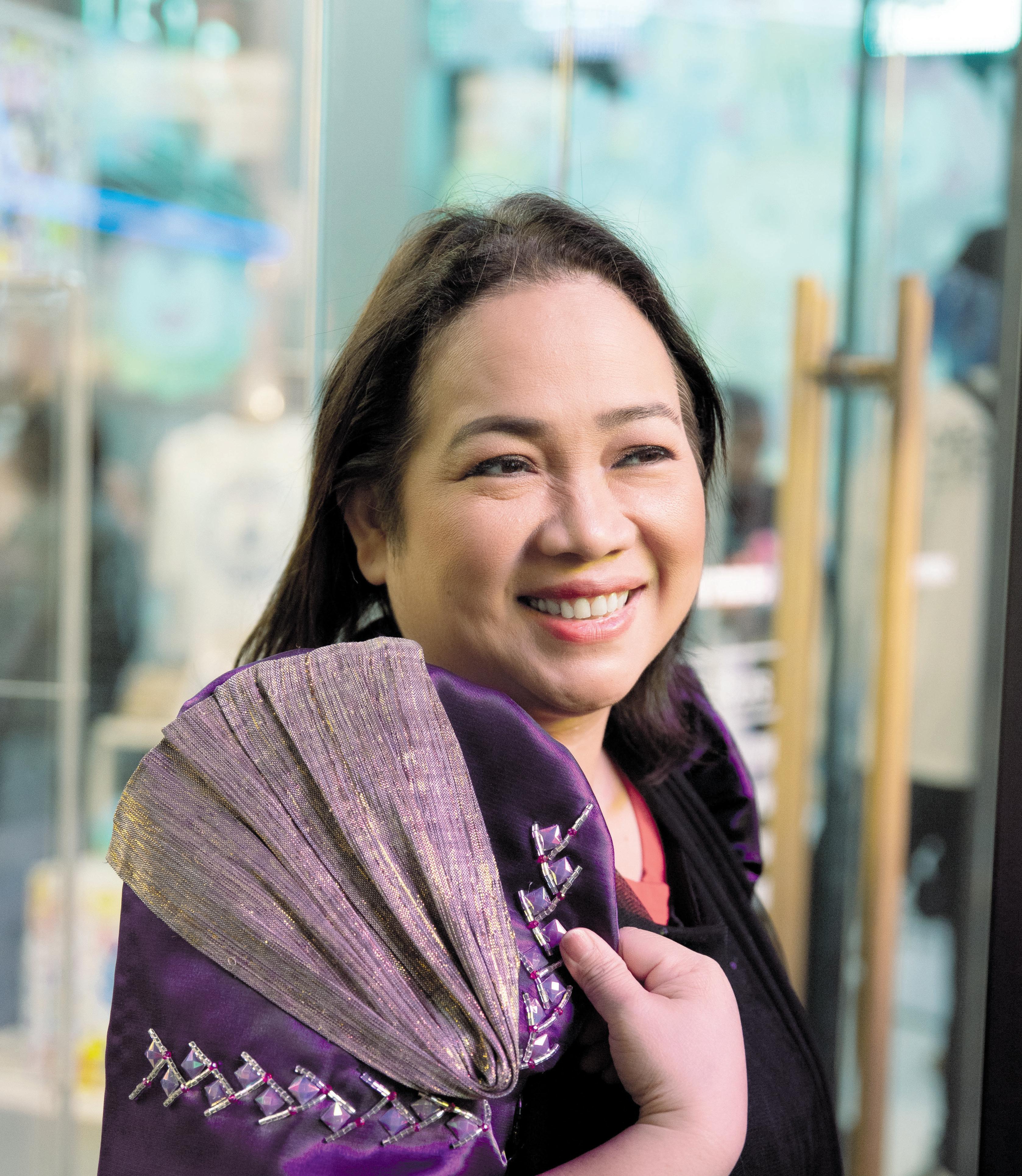
Steadfast designs joins the NYFW runway